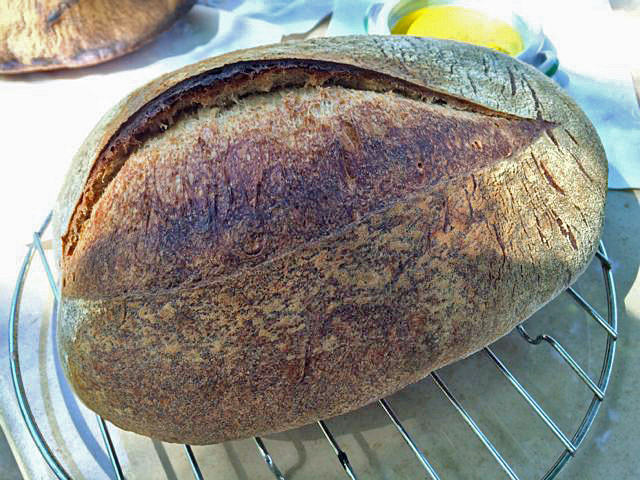I just returned home from my second bake in a wood fired oven. My first bake, about 3 weeks ago, is described in My first WFO bake: Lessons in time, temperature and humility. That experience demonstrated the wisdom of the advice I had received, especially the advice I disregarded.
Last week, I got a phone call from my friend, L. , inviting me to a potluck dinner at J.'s where members of the Italian social group that meets weekly at J.'s store would be eager to sample my bread, baked in J.'s WFO. Yikes! A "command performance!" So, I called J. and told her I needed another "practice session" before baking for 20 hungry Italians.
I re-read all the TFL responses to my request for WFO words of wisdom and, from them, distilled a protocol that I shared with J. She translated it into a concrete schedule, and we agreed on a date and time for the practice session, which was today.
I added one item to the list of suggestions: Because of the incredible oven spring with burst loaves I had from the first WFO bake, it seemed to me that I should more fully proof the loaves to reduce the oven spring to a more "normal," controlled level.
J. Fired her oven at 4 am. I arrived at her house at 2 pm. In retrospect, she had built too big a fire. The oven floor was over 750 dF, and the coals were still burning. We shoveled out the coals, and in about an hour the oven was cool enough (around 500 dF) to try baking bread. We decided to do one of the 3 loaves first, just in case ... I choose a 1 Kg boule of my San Francisco-style Sourdough Bread with increased whole wheat flour. We had a large cast iron skill filled with water in the back of the oven. We mopped the floor with a damp cloth. I loaded the boule, shut the door for 20 minutes. Then I peaked and rotated the loaf. It baked for 25 minutes.

After baking the other loaves - two 900g bâtards of Hamelman's Pain au Levain with Whole Wheat -, we sliced the SFSD and tasted it with some fantastic local olive oil which I am going to have to buy next time I'm at J.'s store.


The bâtards had a slightly cooler oven. They baked in about 26 minutes and were less darkly colored.

As you can see, these loaves have a somewhat dull crust. This is because the oven could not be adequately humidified. It's big and really needed to be baking 15, 20 or more loaves at once to function optimally. However, the tasting is the critical test.
The SFSD with increase whole wheat was simply the best tasting bread I have ever baked. The crust was very crunchy. The crumb was well-aerated, very tender and light. The crust had a dark, nutty, mildly bitter flavor which was offset by the very sweet, milky flavor of the crumb. There was a subtle, late-appearing but lingering acetic acid tang, but the lactic acid flavor was much more prominent. After tasting a slice, with and without olive oil and declaring it delicious, J. said, "You know, growing up, I never liked sourdough bread, but this is wonderful."
Before I left for home, we set a schedule for preparing the oven and baking the breads for the potluck. I'm ready to party!
I couldn't have learned what I have learned in just two bakes without the wonderful, generous wisdom shared by TFL members mrvegemite, yozzause, Sjadad, Arlo, etheil, BobSponge, embth, and Josh. Thanks, guys! You make me (even more) proud to be a member of this community.
David